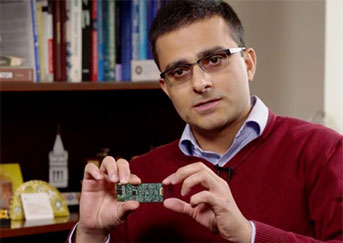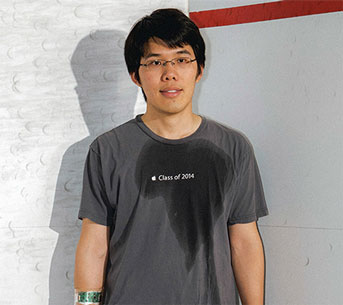

| Online: | |
| Visits: | |
| Stories: |

| Story Views | |
| Now: | |
| Last Hour: | |
| Last 24 Hours: | |
| Total: | |
What Sweat Sensors Can Tell About Your Health in Real Time
Current tests monitor these telltale signs only periodically, missing short-term fluctuations or suddenly spiking concentrations.
Imbedded in a sweatband, a network of sensors devised by Ali Javey can monitor moment-by-moment changes in electrolytes and metabolites, a potential boon to weekend athletes, diabetics and people exposed to heavy metal concentrations.

Credit: Roxanne Makasdjian and Stephen McNally
But in a Cory Hall lab that’s been converted into a high tech mini-fitness center, researchers can now trace these metabolic changes second by second in a substance any good work out produces: sweat.
Credit: Video produced by Roxanne Makasdjian and Stephen McNally, UC Berkeley
Ali Javey, a materials scientist and professor of electrical engineering and computer sciences, has combined innovative materials, sensor technology and integrated circuits to develop a wearable sweat sensor network that can measure rapid fluctuations in electrolytes and metabolites, and even the buildup of heavy metal concentrations in perspiration.
Moment-by-moment tracking
Prototype sweat sensors are printed on thin plastics and are embedded in headbands or wristbands to monitor concentration levels of these metabolic markers in real-time.
The lightweight sensor network tracks half a dozen chemical markers in sweat as volunteers toil on a bike in his lab. The sensors within the film are connected to a flexible electronic board with silicon Integrated Circuits. The circuit board converts the voltage and current measures of the sensors to a readout of electrolyte or metabolite concentration.
As they huff and puff, runners can monitor spikes or dips in their electrolytes, metabolites and skin temperature on a smart phone or other mobile device via Bluetooth. The readouts can also be transmitted wirelessly to other sites for more detailed analysis.
Supported by the 2016-17 Bakar Fellows Program, Javey is refining the sensor fabrication process to make it more commercially practical for fitness training, athletics, health diagnostics and even large-scale population studies.
Tracking prediabetes and lead exposure
“About half of the California adult population is prediabetic,” Javey says. “It is an alarming condition that leads to diabetes if your eating and living habits don’t change. But most people don’t know they have the condition. And many of us hate going to the doctor — and hate blood draws to determine blood glucose levels.”
Just off the squash court, postdoctoral fellow Wei Gao wears a sweat sensor that monitored electrolyte and metabolite levels as he exercised. Gao helped develop the wearable sweat sensors and published a paper with Ali Javey describing the innovation. The paper received global attention.

Credit: Courtesy of MIT Technology Review
Preliminary research suggests that sweat may be a reliable reservoir to draw on for moment-to-moment glucose measures, Javey says. Sweat sensors could provide the first non-invasive and inexpensive home test. In addition, the sensors could potentially be used to detect the onset of fatigue and dehydration in athletes during prolonged exercise activities. Finally, Javey and team has explored detection of heavy metals (e.g., lead) in sweat as an early exposure detection to these toxic species.
This networked capacity offers the chance to study how different molecular concentrations vary in relation to each other. Doing so could potentially help in assessing health conditions or disease risk.
The sensors on the wristband or headband are chemically coated electrodes that measure voltage or current as a proxy for electrolyte concentration. Electrodes differ based on the type of chemical they are designed to detect. The integrated circuit portion of this wearable device converts the measured voltage and current to a readout of a given chemical concentration. Since signal output is temperature-sensitive, the chip is also needed to continuously calibrate the sensors to assure they accurately record concentration as the sweat temperature changes.
As his lab advances the sensor network innovation from a prototype to a potentially commercial device, Javey intends to tap the tech transfer expertise of mentors in the Bakar Fellows Program, with the aim of developing a company produce and market the technology.
Contacts and sources:


